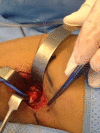Fibroepithelial Polyp in a Child: A Rare Pathology of Upper Urinary Tract Obstruction
- PMID: 32714686
- PMCID: PMC7377021
- DOI: 10.7759/cureus.8748
Fibroepithelial Polyp in a Child: A Rare Pathology of Upper Urinary Tract Obstruction
Abstract
Fibroepithelial polyp is a rare benign tumor of the urothelial system that originates from the mesoderm. Polyps are usually small and located in the upper urinary tract and ureteropelvic junction. However, in the pediatric population, such polyps are more common in the posterior urethra and will present with symptoms of urinary tract obstruction. Some will present with flank pain and hematuria, resembling symptoms of ureteric stones. In this case, we discuss a nine-year-old boy presenting with complaints of flank pain and hematuria for one year. Following laboratory and radiological investigations, the left ureter was dilated at the mid-lumbar region with an anteroposterior diameter of 2.3 x 0.6 cm and a left renal pelvis anteroposterior diameter of 2.2 cm. An ultrasound scan identified an intraluminal lesion suspected to be a fibroepithelial polyp. Management was carried out via retroperitoneal surgery with upper ureteral resection and end-to-end anastomosis. Postoperatively, the patient's symptoms improved, and a subsequent ultrasound scan and renal function test showed improvement of the left hydroureter and hydronephrosis.
Keywords: fibroepithelial polyp; hydronephrosis; hydroureter; upper urinary tract obstruction.
Copyright © 2020, Alhindi et al.
Conflict of interest statement
The authors have declared that no competing interests exist.
Figures



References
-
- Fibroepithelial polyps causing ureteropelvic junction obstruction in children. Adey GS, Vargas SO, Retik AB, et al. J Urol. 2003;169:1834–1836. - PubMed
-
- Benign ureteral fibrous polyp as a cause of obstruction in children. Roodhooft AM, Gentens P, Van Acker KJ. Pediatr Radiol. 1985;15:429–430. - PubMed
-
- Endoscopic treatment of a long fibroepithelial ureteral polyp. Yagi S, Kawano Y, Gotanda T, Kitagawa T, Kawahara M, Nakagawa M, Higashi Y. Int J Urol. 2001;8:467–469. - PubMed
-
- Diagnosis and management of ureteral fibroepithelial polyps in children: a new treatment algorithm. Li R, Lightfoot M, Alsyouf M, Nicolay L, Baldwin DD, Chamberlin DA. J Pediatr Urol. 2015;11:22. - PubMed
-
- Utilizing ultrasonography in the diagnosis of pediatric fibroepithelial polyps causing ureteropelvic junction obstruction. Wang XM, Jia LQ, Wang Y, Wang N. Pediatr Radiol. 2012;42:1107–1111. - PubMed
Publication types
LinkOut - more resources
Full Text Sources
